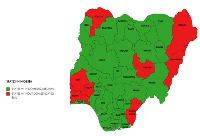Assessment of the Knowledge, Availability, and Use of the Essential Medicines List in the 36 States plus FCT in Nigeria
DOI:
https://doi.org/10.51412/psnnjp.2024.08Keywords:
Planning, Procurement, Domesticated, Essential Medicines ListAbstract
Background: The Essential Medicines List (EML) is an important tool in global health and supports the achievement of the UN Sustainable Development Goals (SDGs). It is a list that contains essential medicines that satisfy a population's priority healthcare needs. These medicines should be readily available in adequate amounts at all times within the healthcare facility and the country at large. This study assessed the knowledge, availability, and use of EMLin the 36 States plus FCTin Nigeria.
Methods: The evaluation was a cross-sectional online survey that involved the use of Google Forms containing 11 EML-related questions with a mixed method of data collection. Aresponse was expected from one State representative who was either the Directors of Pharmaceutical Services (DPS) or another resource person with extensive knowledge about the State EML in the 36 State Ministries of Health and the FCT who consented to participate in the study. Descriptive statistics was used to analyze the data via Microsoft Excel software 2016, with the results expressed as counts and percentages, and presented in the form of charts and tables.
Results: Thirty-five (35) out of 37 representing 95% of respondents are the directors of pharmaceutical services in their States except for two States that provided other resource persons. All 37 (100%) respondents are aware of the document and know about it. Twenty-nine (78.4%) States have domesticated EML and 8 (21.6%) States have never had a domesticated EML. Twelve (41.4%) States of the 29 States with a reviewed EML have reviewed their EML since inception while 17 (58.6%) States have never reviewed the document since its inception. All 29 (78.4%) States with a domesticated EMLdefer to the policy document for procurement and planning in their States.
Conclusion: The EML is an important document for every country's health system. The study successfully assessed the knowledge of the EML in the 36 States plus the FCT in Nigeria. The high level of awareness of the EML translated to knowledge and utilization of the document among the majority of the States in Nigeria.
References
WHO (2021). Model list of essential medicines 22nd list, 2021, 30 September 2021 https://www.who.int/publications/i/item/WHOMHP-HPS-EML-2021.02 (accessed 15/4/2022)
A Journal of peer-reviewed Research (2010)Making the List: The Role of Essential Medicines in Reproductive Health. International
Perspective on Sexual and Reproductive Health. 2010; 38(4):205-208. Published December 14, 2010.
WHO. The selection and Use of Essential Medicines. Report of a WHO expert committee, WHO Technical Report Series,
;946,2007,p81, Geneva, Switzerland.
IMS Institute for Health Informatics. Ensuring Essential Medicines Satisfy Priority Healthcare Needs of Populations: Evolution, Current State and Future Needs 2016. https://www.ifpma.org/resource-centre/ensuring-essentialmedicines-satisfypriority-healthcare-needs-of-populations/. (accessed 02/042022)
WHO. Bulletin of the World Health Organization 2002,80 (11).Geneva, Switzerland.
McCarthy, M. What makes an essential medicine? WHO's new list focuses on antibiotic resistance, adds expensive drugs, and downgrades Tamiflu. BMJ 2017;358:j3505. doi: 10.1136/bmj.j3044;
Kishore SP, Blank E, Heller DJ, Patel A, Peters A, Price M, Vidula M, Fuster V, Onuma O, Huffman MD, Vedanthan R. Modernizing the World Health Organization List of Essential Medicines for Preventing and Controlling Cardiovascular Diseases. J Am Coll Cardiol. 2018 Feb
; 71(5): 564 - 574. doi:10.1016/j.jacc.2017.11.056
Marks, V. et al. On Essentiality and the World Health Organization's Model List of Essential Medicines. Annals of Global Health, vol. 83, no. 3 - 4 . http://dx.doi.org/10.1016/j.aogh.2017.05.005.
IFPMA (2019). Position paper on the WHO Essential Medicines List. P2 -7. https://www.ifpma.org/wp-content/uploads/2023/01/i2023_EML-PP_Mar2019.pdf (accessed 2/04/2022)
Federal Ministry of Health. Nigeria Essential th Medicines List for Adults (7 Edition 2020) P-ii
WHO EMRO (Essential medicines and pharmaceutical policies-Entity-http://www.emro.who.int/entity/essentialmedicines/index.html(accessed 16/4/2022)
Ayinbuomwan SA, Opadeyi AO, Ohaju-Obodo JO, Akhideno PE, Oghuvwu SO, Nwani PO, James BO, Isah AO. An Evaluation of the
Knowledge and Utilization of the Essential Medicines List among Health Professionals in Six Tertiary Institutions in Nigeria. West Afr J
Med. 2023 Jun 29;40(6):575-580. (accessed 28/03/2022)
Hassan A, Abduhalli GA, Ahmed AA, Sabiu A, John U, Ezekeil G & Ibrahim YA. Assessing prescriber's awareness of essential medicines list, Hospital drug formulary and Utilization of Standard Treatment Guidelines in a tertiary healthcare facility in North-Central Nigeria. Alex J Med. 2017;03: 006-009
WHO. Medicines Strategy. Revised procedure for updating WHO's model List of Essential drugs, EB109/8. World Health Organization. 2001. (accessed 3/04/2022)
Adikwu MU, Osondu BO. Four years of essential drugs' list in Nigeria. Soc Sci Med.1991;33(9):1005-10. doi:10.1016/0277-
(91)90005-w. PMID:1771427.
Kar SS, Pradhan SH, & Mohanta GP. Concept of Essential Medicines and Rational Use in Public Health. Indian J Community Med. 2010 Jan; 35(1): 10-13. Doi:10.4103/0970-0218.62546. PMCID: PMC2888334 | PMID: 20606912.

Downloads
Views | PDF Downloads:
520
/ 246
Published
How to Cite
Issue
Section
License
Copyright (c) 2024 The Nigerian Journal of Pharmacy

This work is licensed under a Creative Commons Attribution-NonCommercial 4.0 International License.


